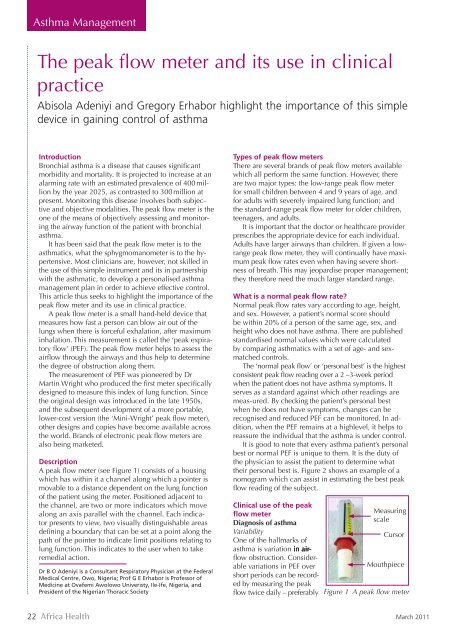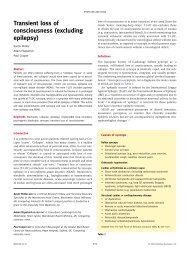The peak flow meter and its use in clinical practice - Africa Health
The peak flow meter and its use in clinical practice - Africa Health
The peak flow meter and its use in clinical practice - Africa Health
Create successful ePaper yourself
Turn your PDF publications into a flip-book with our unique Google optimized e-Paper software.
Asthma Management<br />
<strong>The</strong> <strong>peak</strong> <strong>flow</strong> <strong>meter</strong> <strong>and</strong> <strong>its</strong> <strong>use</strong> <strong>in</strong> cl<strong>in</strong>ical<br />
<strong>practice</strong><br />
Abisola Adeniyi <strong>and</strong> Gregory Erhabor highlight the importance of this simple<br />
device <strong>in</strong> ga<strong>in</strong><strong>in</strong>g control of asthma<br />
Introduction<br />
Bronchial asthma is a disease that ca<strong>use</strong>s significant<br />
morbidity <strong>and</strong> mortality. It is projected to <strong>in</strong>crease at an<br />
alarm<strong>in</strong>g rate with an estimated prevalence of 400 million<br />
by the year 2025, as contrasted to 300 million at<br />
present. Monitor<strong>in</strong>g this disease <strong>in</strong>volves both subjective<br />
<strong>and</strong> objective modalities. <strong>The</strong> <strong>peak</strong> <strong>flow</strong> <strong>meter</strong> is the<br />
one of the means of objectively assess<strong>in</strong>g <strong>and</strong> monitor<strong>in</strong>g<br />
the airway function of the patient with bronchial<br />
asthma.<br />
It has been said that the <strong>peak</strong> <strong>flow</strong> <strong>meter</strong> is to the<br />
asthmatics, what the sphygmomano<strong>meter</strong> is to the hypertensive.<br />
Most cl<strong>in</strong>icians are, however, not skilled <strong>in</strong><br />
the <strong>use</strong> of this simple <strong>in</strong>strument <strong>and</strong> <strong>its</strong> <strong>in</strong> partnership<br />
with the asthmatic, to develop a personalised asthma<br />
management plan <strong>in</strong> order to achieve effective control.<br />
This article thus seeks to highlight the importance of the<br />
<strong>peak</strong> <strong>flow</strong> <strong>meter</strong> <strong>and</strong> <strong>its</strong> <strong>use</strong> <strong>in</strong> cl<strong>in</strong>ical <strong>practice</strong>.<br />
A <strong>peak</strong> <strong>flow</strong> <strong>meter</strong> is a small h<strong>and</strong>-held device that<br />
measures how fast a person can blow air out of the<br />
lungs when there is forceful exhalation, after maximum<br />
<strong>in</strong>halation. This measurement is called the ‘<strong>peak</strong> expiratory<br />
<strong>flow</strong>’ (PEF). <strong>The</strong> <strong>peak</strong> <strong>flow</strong> <strong>meter</strong> helps to assess the<br />
air<strong>flow</strong> through the airways <strong>and</strong> thus help to determ<strong>in</strong>e<br />
the degree of obstruction along them.<br />
<strong>The</strong> measurement of PEF was pioneered by Dr<br />
Mart<strong>in</strong> Wright who produced the first <strong>meter</strong> specifically<br />
designed to measure this <strong>in</strong>dex of lung function. S<strong>in</strong>ce<br />
the orig<strong>in</strong>al design was <strong>in</strong>troduced <strong>in</strong> the late 1950s,<br />
<strong>and</strong> the subsequent development of a more portable,<br />
lower-cost version (the ‘M<strong>in</strong>i-Wright’ <strong>peak</strong> <strong>flow</strong> <strong>meter</strong>),<br />
other designs <strong>and</strong> copies have become available across<br />
the world. Br<strong>and</strong>s of electronic <strong>peak</strong> <strong>flow</strong> <strong>meter</strong>s are<br />
also be<strong>in</strong>g marketed.<br />
Description<br />
A <strong>peak</strong> <strong>flow</strong> <strong>meter</strong> (see Figure 1) consists of a hous<strong>in</strong>g<br />
which has with<strong>in</strong> it a channel along which a po<strong>in</strong>ter is<br />
movable to a distance dependent on the lung function<br />
of the patient us<strong>in</strong>g the <strong>meter</strong>. Positioned adjacent to<br />
the channel, are two or more <strong>in</strong>dicators which move<br />
along an axis parallel with the channel. Each <strong>in</strong>dicator<br />
presents to view, two visually dist<strong>in</strong>guishable areas<br />
def<strong>in</strong><strong>in</strong>g a boundary that can be set at a po<strong>in</strong>t along the<br />
path of the po<strong>in</strong>ter to <strong>in</strong>dicate limit positions relat<strong>in</strong>g to<br />
lung function. This <strong>in</strong>dicates to the <strong>use</strong>r when to take<br />
remedial action.<br />
Dr B O Adeniyi is a Consultant Respiratory Physician at the Federal<br />
Medical Centre, Owo, Nigeria; Prof G E Erhabor is Professor of<br />
Medic<strong>in</strong>e at Ovafemi Awolowo Univeristy, Ile-Ife, Nigeria, <strong>and</strong><br />
President of the Nigerian Thoracic Society<br />
Types of <strong>peak</strong> <strong>flow</strong> <strong>meter</strong>s<br />
<strong>The</strong>re are several br<strong>and</strong>s of <strong>peak</strong> <strong>flow</strong> <strong>meter</strong>s available<br />
which all perform the same function. However, there<br />
are two major types: the low-range <strong>peak</strong> <strong>flow</strong> <strong>meter</strong><br />
for small children between 4 <strong>and</strong> 9 years of age, <strong>and</strong><br />
for adults with severely impaired lung function; <strong>and</strong><br />
the st<strong>and</strong>ard-range <strong>peak</strong> <strong>flow</strong> <strong>meter</strong> for older children,<br />
teenagers, <strong>and</strong> adults.<br />
It is important that the doctor or healthcare provider<br />
prescribes the appropriate device for each <strong>in</strong>dividual.<br />
Adults have larger airways than children. If given a lowrange<br />
<strong>peak</strong> <strong>flow</strong> <strong>meter</strong>, they will cont<strong>in</strong>ually have maximum<br />
<strong>peak</strong> <strong>flow</strong> rates even when hav<strong>in</strong>g severe shortness<br />
of breath. This may jeopardise proper management;<br />
they therefore need the much larger st<strong>and</strong>ard range.<br />
What is a normal <strong>peak</strong> <strong>flow</strong> rate<br />
Normal <strong>peak</strong> <strong>flow</strong> rates vary accord<strong>in</strong>g to age, height,<br />
<strong>and</strong> sex. However, a patient’s normal score should<br />
be with<strong>in</strong> 20% of a person of the same age, sex, <strong>and</strong><br />
height who does not have asthma. <strong>The</strong>re are published<br />
st<strong>and</strong>ardised normal values which were calculated<br />
by compar<strong>in</strong>g asthmatics with a set of age- <strong>and</strong> sexmatched<br />
controls.<br />
<strong>The</strong> ‘normal <strong>peak</strong> <strong>flow</strong>’ or ‘personal best’ is the highest<br />
consistent <strong>peak</strong> <strong>flow</strong> read<strong>in</strong>g over a 2 –3-week period<br />
when the patient does not have asthma symptoms. It<br />
serves as a st<strong>and</strong>ard aga<strong>in</strong>st which other read<strong>in</strong>gs are<br />
meas-ured. By check<strong>in</strong>g the patient’s personal best<br />
when he does not have symptoms, changes can be<br />
recognised <strong>and</strong> reduced PEF can be monitored. In addition,<br />
when the PEF rema<strong>in</strong>s at a highlevel, it helps to<br />
reassure the <strong>in</strong>dividual that the asthma is under control.<br />
It is good to note that every asthma patient’s personal<br />
best or normal PEF is unique to them. It is the duty of<br />
the physician to assist the patient to determ<strong>in</strong>e what<br />
their personal best is. Figure 2 shows an example of a<br />
nomogram which can assist <strong>in</strong> estimat<strong>in</strong>g the best <strong>peak</strong><br />
<strong>flow</strong> read<strong>in</strong>g of the subject.<br />
Cl<strong>in</strong>ical <strong>use</strong> of the <strong>peak</strong><br />
<strong>flow</strong> <strong>meter</strong><br />
Diagnosis of asthma<br />
Variability<br />
One of the hallmarks of<br />
asthma is variation <strong>in</strong> air<strong>flow</strong><br />
obstruction. Considerable<br />
variations <strong>in</strong> PEF over<br />
short periods can be recorded<br />
by measur<strong>in</strong>g the <strong>peak</strong><br />
<strong>flow</strong> twice daily – preferably<br />
Measur<strong>in</strong>g<br />
scale<br />
Cursor<br />
Mouthpiece<br />
Figure 1 A <strong>peak</strong> <strong>flow</strong> <strong>meter</strong><br />
22 <strong>Africa</strong> <strong>Health</strong><br />
March 2011
Asthma Management<br />
decide the suitability of patients for discharge after<br />
an acute severe attack. Large dips <strong>in</strong> read<strong>in</strong>gs are an<br />
<strong>in</strong>dication that their asthma is not yet under control, <strong>and</strong><br />
calls for cont<strong>in</strong>ued modification of therapy. <strong>The</strong> diurnal<br />
variation should also be less than 25%. Patients should<br />
be discharged if their PEFR has returned to normal or at<br />
least 75% of the predicted or best value.<br />
Figure 2 Normal values for PER (EN 13826 or EU scale)<br />
morn<strong>in</strong>gs <strong>and</strong> even<strong>in</strong>gs. Patients with asthma often show<br />
diurnal variation with read<strong>in</strong>gs fall<strong>in</strong>g sharply <strong>in</strong> the<br />
night or early morn<strong>in</strong>gs, the so-called ‘early morn<strong>in</strong>g<br />
dips’. Variation of at least 15% of established maximum<br />
is assumed to be <strong>in</strong>dicative of asthma.<br />
Bronchodilator response<br />
Another characteristic of asthma is reversibility with <strong>in</strong>haled<br />
bronchodilators. If the patient <strong>in</strong>hales a short–act<strong>in</strong>g<br />
b2 agonist such as salbutamol, terbutal<strong>in</strong>e sulfate, or<br />
antichol<strong>in</strong>ergics, a bronchodilator response greater than<br />
15% <strong>in</strong> PEF is <strong>in</strong>dicative of asthma.<br />
Exercise test<strong>in</strong>g<br />
Exercise is known to <strong>in</strong>duce bronchospasm <strong>in</strong> over 80%<br />
of asthma patients. Exercise challenge has been <strong>in</strong> <strong>use</strong><br />
for several years <strong>in</strong> the diagnosis of asthma, especially<br />
<strong>in</strong> children. <strong>The</strong> st<strong>and</strong>ard technique is to exercise the<br />
asthma patient for about 6–8 m<strong>in</strong>utes on a treadmill,<br />
or <strong>in</strong> some cases free runn<strong>in</strong>g on an open field; a fall<br />
of PEF rate greater than 15% is <strong>in</strong>dicative of<br />
asthma.<br />
Occupational asthma<br />
Demonstration of work-related asthma can be<br />
done by frequent read<strong>in</strong>gs of the <strong>peak</strong> <strong>flow</strong><br />
every 2 hours throughout the day or when the<br />
patient is awake, for about 4 weeks. However,<br />
a reasonable diagnosis can be made by hav<strong>in</strong>g<br />
patients record their <strong>peak</strong> <strong>flow</strong> read<strong>in</strong>g three or<br />
four times daily, preferably before the first shift,<br />
after a break, at the end of a shift, <strong>and</strong> before<br />
report<strong>in</strong>g for work the next day. In occupational<br />
asthma there is a progressive fall <strong>in</strong> <strong>peak</strong> <strong>flow</strong><br />
rates over several days <strong>and</strong> failure to return fully<br />
to normal. <strong>The</strong>re is also progressive recovery<br />
on work cessation over several days, with or<br />
without medication (see Figure 3).<br />
Self-management plan<br />
Asthma is an unpredictable disease, <strong>and</strong> this is especially<br />
so with those whose asthma is severe or unstable.<br />
<strong>The</strong>se patients are better managed with an asthma selfmanagement<br />
plan us<strong>in</strong>g a diary <strong>and</strong> a <strong>peak</strong> <strong>flow</strong> <strong>meter</strong>.<br />
A simple plan is to stick coloured tape on the <strong>peak</strong> <strong>flow</strong><br />
<strong>meter</strong> to correspond to agreed zones or levels, with<br />
specific <strong>in</strong>struction of what to do at each level. Before<br />
the asthma patient can <strong>use</strong> this guide, he/she would<br />
have recorded his <strong>peak</strong> <strong>flow</strong> read<strong>in</strong>g consistently morn<strong>in</strong>g<br />
<strong>and</strong> even<strong>in</strong>g for at least 2 weeks <strong>and</strong> thus know his<br />
estimated best PEF values.<br />
Usually the traffic light colour code is <strong>use</strong>d. Figure 4<br />
summarises what each code <strong>in</strong>dicates <strong>and</strong> the required<br />
action by the patient.<br />
How to <strong>use</strong> the <strong>peak</strong> <strong>flow</strong> <strong>meter</strong><br />
<strong>The</strong> patient must be well <strong>in</strong>structed <strong>and</strong> if possible have<br />
a practical demonstration so as to get the correct read<strong>in</strong>g.<br />
<strong>The</strong> <strong>peak</strong> <strong>flow</strong> rates should be recorded on a <strong>peak</strong><br />
<strong>flow</strong> chart. <strong>The</strong> patient is required to chart the highest of<br />
three read<strong>in</strong>gs. This is the best for the period. A typical<br />
chart has dates with AM <strong>and</strong> PM, a left marg<strong>in</strong> with a<br />
scale start<strong>in</strong>g from 0 l/m<strong>in</strong> at the bottom <strong>and</strong> end<strong>in</strong>g<br />
with 600 l/m<strong>in</strong> at the top. It should also conta<strong>in</strong> space at<br />
the bottom to record symptoms, possible triggers, <strong>and</strong><br />
medications <strong>use</strong>d. Figure 5 is an example of a <strong>peak</strong> <strong>flow</strong><br />
chart show<strong>in</strong>g the progression <strong>in</strong> the <strong>peak</strong> <strong>flow</strong> rates of<br />
an asthmatic before <strong>and</strong> after treatment.<br />
When to <strong>use</strong> the <strong>peak</strong> <strong>flow</strong> <strong>meter</strong><br />
A <strong>peak</strong> <strong>flow</strong> <strong>meter</strong> should be <strong>use</strong>d regularly to monitor<br />
asthma control. It is also a valuable tool to monitor<br />
the effectiveness of short-term bronchodilators (rescue<br />
Monitor<strong>in</strong>g disease progress<br />
<strong>The</strong> <strong>peak</strong> <strong>flow</strong> measurement can be <strong>use</strong>d to<br />
Figure 3 Peak <strong>flow</strong> <strong>meter</strong> read<strong>in</strong>g of a foam worker with occupational<br />
asthma from toluene diisocyanate (TDI)<br />
March 2011<br />
<strong>Africa</strong> <strong>Health</strong> 23
Asthma Management<br />
Green zone: <strong>The</strong> <strong>peak</strong> <strong>flow</strong> read<strong>in</strong>g is between<br />
80–100% of the patient’s personal best. This<br />
is the ‘all-clear’ zone. <strong>The</strong>re are no symptoms,<br />
he can do normal activities <strong>and</strong> have a sound<br />
sleep. He should cont<strong>in</strong>ue his usual treatments<br />
(bronchodilators when needed with or without regular<br />
<strong>in</strong>haled seroids.<br />
Yellow zone: Peak <strong>flow</strong> read<strong>in</strong>g is between<br />
50–79% of patient’s personal best. This is the<br />
‘caution’ zone. Asthma may be gett<strong>in</strong>g wrose.<br />
<strong>The</strong> patient may be cough<strong>in</strong>g, wheez<strong>in</strong>g, sleep<strong>in</strong>g<br />
poorly, or hav<strong>in</strong>g restricted activities. He should<br />
take action to ga<strong>in</strong> control <strong>and</strong> needs to adjust his<br />
medications, as recommended by the doctor.<br />
Red zone: Peak <strong>flow</strong> read<strong>in</strong>g is less than 50% of<br />
the patient’s best. This is an asthma emergency!<br />
Patients may be cough<strong>in</strong>g, dyspnoeic <strong>and</strong> hav<strong>in</strong>g<br />
sleep disturbances with frequent awaken<strong>in</strong>gs <strong>in</strong><br />
one night <strong>and</strong> most nights. He may be unable to complete<br />
sentences <strong>in</strong> one breath. <strong>The</strong> patient is advised to<br />
take a reliever medication such as the short-act<strong>in</strong>g b-2<br />
agonist medication <strong>and</strong> start an oral dose of steroids.<br />
He should call the doctor or go to hospital immediately<br />
if these symptoms persist or he develops blue lips<br />
or f<strong>in</strong>gers, or if the <strong>peak</strong> <strong>flow</strong> is still <strong>in</strong> the Red Zone<br />
30 m<strong>in</strong>utes later.<br />
Figure 4 An example of a self-management plan for asthma<br />
medications) dur<strong>in</strong>g an acute episode of asthma. It is<br />
therefore recommended for <strong>use</strong>:<br />
• every morn<strong>in</strong>g before the patient takes his asthma<br />
medications <strong>and</strong> <strong>in</strong> the even<strong>in</strong>gs. It is preferable to<br />
<strong>use</strong> the <strong>peak</strong> <strong>flow</strong> <strong>meter</strong> at the same time every day<br />
<strong>and</strong> record symptoms;<br />
• when hav<strong>in</strong>g asthma symptoms that either wake the<br />
patient at night or are <strong>in</strong>creased dur<strong>in</strong>g the day, or<br />
Figure 5 An example of a <strong>peak</strong> <strong>flow</strong> chart<br />
CPD Challenge<br />
See page 61 to test yourself on this article<br />
when the patient needs rescue medication;<br />
• dur<strong>in</strong>g an attack of asthma;<br />
• after tak<strong>in</strong>g medication for an asthma attack.<br />
• as recommended by the health practitioner.<br />
What are the advantages of a <strong>peak</strong> <strong>flow</strong> <strong>meter</strong><br />
• <strong>The</strong> <strong>peak</strong> <strong>flow</strong> <strong>meter</strong> is small, <strong>in</strong>expensive, easy to<br />
<strong>use</strong>, portable, <strong>and</strong> h<strong>and</strong>-held, <strong>and</strong> does not need to<br />
be plugged <strong>in</strong>. Once a patient has been taught how<br />
to <strong>use</strong> it he does not need supervision.<br />
• It is <strong>use</strong>ful for diagnos<strong>in</strong>g asthma.<br />
• It helps to monitor the progress of disease, <strong>and</strong> is<br />
<strong>use</strong>ful <strong>in</strong> self-management of asthma. When properly<br />
<strong>use</strong>d it can recognise early changes <strong>and</strong> reveal narrow<strong>in</strong>g<br />
of the airways well <strong>in</strong> advance (hours or even<br />
days) of an asthma attack. This helps the patient to<br />
take his rescue medications <strong>and</strong> pre-empt an attack.<br />
• It enables the asthma patient to measure the day-today<br />
variation <strong>in</strong> his breath<strong>in</strong>g accurately.<br />
• It helps to identify what is go<strong>in</strong>g on <strong>in</strong> the lungs<br />
rather than guess<strong>in</strong>g by how the patient feels.<br />
• It shows the effectiveness of the asthma medication<br />
<strong>and</strong> management plan.<br />
• It keeps a record of how the patients have been<br />
between cl<strong>in</strong>ic attendance.<br />
• It helps the doctor know when to adjust, add to,<br />
reduce, or stop asthma medications.<br />
• It could help the patient learn what triggers his asthma.<br />
Limitations of a <strong>peak</strong> <strong>flow</strong> <strong>meter</strong><br />
<strong>The</strong> <strong>peak</strong> <strong>flow</strong> <strong>meter</strong> has some limitations. Results are<br />
sometimes not reproducible over a long period <strong>and</strong><br />
there may be <strong>in</strong>ter-model variation <strong>in</strong> the values of<br />
read<strong>in</strong>gs obta<strong>in</strong>ed. It is also effort dependent. It primarily<br />
assesses the air<strong>flow</strong> <strong>in</strong> the larger airways <strong>and</strong> not <strong>in</strong><br />
the medium <strong>and</strong> smaller airways <strong>and</strong> thus can underestimate<br />
the degree of air<strong>flow</strong> limitation, particularly as<br />
air<strong>flow</strong> limitation <strong>and</strong> gas trapp<strong>in</strong>g worsen.<br />
It is good to note that measurement of PEF<br />
is not <strong>in</strong>terchangeable with other measurements<br />
of lung function such as FEV1 (forced<br />
expiratory volume <strong>in</strong> 1 second).<br />
Conclusion<br />
Peak <strong>flow</strong> <strong>meter</strong>s are available <strong>in</strong> medical<br />
equipment <strong>and</strong> drug stores worldwide <strong>and</strong><br />
can be acquired without prescription. It is<br />
advisable for the patient to consult his doctor<br />
to ensure that he is gett<strong>in</strong>g the right type <strong>and</strong><br />
to be given step-by-step <strong>in</strong>structions on how to<br />
<strong>use</strong> the device for maximum effect.<br />
It is good to know that measur<strong>in</strong>g the<br />
<strong>peak</strong> <strong>flow</strong> is just one step <strong>in</strong> ga<strong>in</strong><strong>in</strong>g control<br />
of asthma. It should not be a substitute<br />
for regular medical care <strong>and</strong> cl<strong>in</strong>ic vis<strong>its</strong>.<br />
<strong>The</strong> patient must work <strong>in</strong> partnership with<br />
his physician to develop an effective selfmanagement<br />
plan, learn to avoid his asthma<br />
triggers <strong>and</strong> <strong>use</strong> his asthma medication as<br />
prescribed. It is pert<strong>in</strong>ent, therefore, for the<br />
physician to be familiar with the <strong>peak</strong> <strong>flow</strong> <strong>meter</strong> <strong>and</strong> <strong>its</strong><br />
appropriate <strong>use</strong>.<br />
For further read<strong>in</strong>g on this subject please email editor@fsg.co.uk.<br />
24 <strong>Africa</strong> <strong>Health</strong><br />
March 2011





